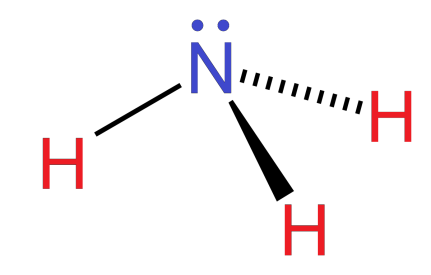
Explain the structure of ammonia.
Answer
509.1k+ views
Hint: The structure of any compound is determined by the VSEPR theory. It determines the type of hybridization present in a compound and its shape.
Complete answer step by step:
Ammonia is a colorless gas having a distinct odor. It is composed of nitrogen and hydrogen atoms. The chemical formula of ammonia is
where,
H = Number of orbitals involved in hybridization.
V = Valence electrons of the central atom.
M = Number of monovalent atoms linked to the central atom.
C = Charge of the cation.
A = Charge of the anion.
In case of ammonia
This means that the no. of orbitals or electron pairs involved are 4. Therefore, the hybridization of

Therefore, ammonia has a trigonal pyramidal shape according to the VSEPR theory. It has an experimental bond angle of
Note: In the above-mentioned case, due to
Complete answer step by step:
Ammonia is a colorless gas having a distinct odor. It is composed of nitrogen and hydrogen atoms. The chemical formula of ammonia is
where,
H = Number of orbitals involved in hybridization.
V = Valence electrons of the central atom.
M = Number of monovalent atoms linked to the central atom.
C = Charge of the cation.
A = Charge of the anion.
In case of ammonia
This means that the no. of orbitals or electron pairs involved are 4. Therefore, the hybridization of

Therefore, ammonia has a trigonal pyramidal shape according to the VSEPR theory. It has an experimental bond angle of
Note: In the above-mentioned case, due to
Recently Updated Pages
Master Class 11 Economics: Engaging Questions & Answers for Success

Master Class 11 Business Studies: Engaging Questions & Answers for Success

Master Class 11 Accountancy: Engaging Questions & Answers for Success

Master Class 11 English: Engaging Questions & Answers for Success

Master Class 11 Computer Science: Engaging Questions & Answers for Success

Master Class 11 Maths: Engaging Questions & Answers for Success

Trending doubts
State and prove Bernoullis theorem class 11 physics CBSE

1 ton equals to A 100 kg B 1000 kg C 10 kg D 10000 class 11 physics CBSE

State the laws of reflection of light

One Metric ton is equal to kg A 10000 B 1000 C 100 class 11 physics CBSE

1 Quintal is equal to a 110 kg b 10 kg c 100kg d 1000 class 11 physics CBSE

Difference Between Prokaryotic Cells and Eukaryotic Cells




